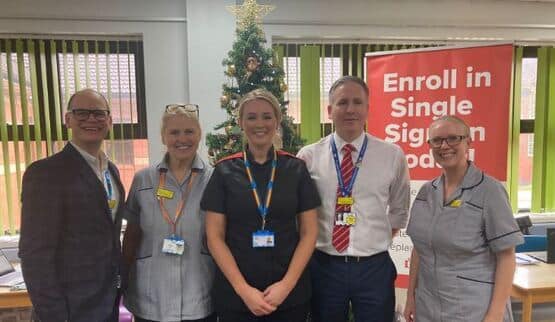The room in the education centre at the Royal Derby Hospital was filled with chatter and buzz just before Christmas as staff from a variety of departments gathered for the largest of six “Paper2Pixel events” hosted by University Hospitals of Derby and Burton (UHDB) NHS Foundation Trust.
The events, the brainchild of the trust’s chief nursing information Officer Stacey Hatton and Heidi Salisbury, senior digital nurse specialist medicine, were an opportunity for employees to contribute examples of documents that will be digitised with the trust set to implement an electronic patient records (EPR) system from Nervecentre over the next two years, while giving them a chance to test drive the system.
Some 330 people attended the Royal Derby Hospital event, with 204 departments across the organisation represented, with more than 600 attending the seven events across the trust, Hatton said.
Speaking to the packed room, Hatton told participants that the event was meant to allow the trust’s leaders to “visualise” the extend of the paper burden, noting that 25% of a nurse’s day is currently spent on documentation.
“We wanted to show that the leadership were heavily involved,” Hatton told Digital Health News. “If people think the leadership approve it, then people are more likely to be inclined to be involved.”
To underscore this point, other speakers at the Royal Derby event included Professor Natasha Philips, founder of Future Nurse and former CNIO at NHS England, who shared her experience of helping to implement the Epic EPR system at University College Hospital in London, and Claire Madon, CNIO at Sherwood Forest Hospitals and the Midlands.
Engaging with the new EPR
In November, UHDB and and Chesterfield Royal Hospital (CRH) – selected Nervecentre as the preferred bidder to supply their joint EPR. Chesterfield did not participate in the Paper2Pixels events, but was expected to hold its own event, Hatton said.
Although a number of other trusts have hosted similar “paper amnesty” events, Hatton said she wasn’t aware of other events that featured an opportunity to engage with the EPR supplier.
Participants were positive about the functionality of Nervecentre in their feedback, she added, and the events helped to recruit digital champions at each of the sites where they took place.
Executive chief nurse of UHDB Garry Marsh told the audience that he considered leaving a digital legacy to be part of his role.
“We move staff around more commonly now between the sites, and actually, we need to see a commonality of documentation,” he said, noting that although the trust has five separate sites, some staff work across more than one of them.
“For every different piece of paper that has no interdependency, it can be lost, and that’s a risk. That’s a safety issue for people using services and it’s also a professional risk for you.”
Hatton also noted that the “visualisation” at the centre of the Paper2Pixel events would help the trust shape the EPR implementation process.


15 January 2024 @ 19:36
Having worked in the industry for a number of years, I have seen many suppliers do just this. This is great, but far from unique.